Celebrating 75 Years of MDA Mission Milestones
For 75 years, MDA’s impact has been shaped by a remarkable community whose dedication has driven life-changing progress.
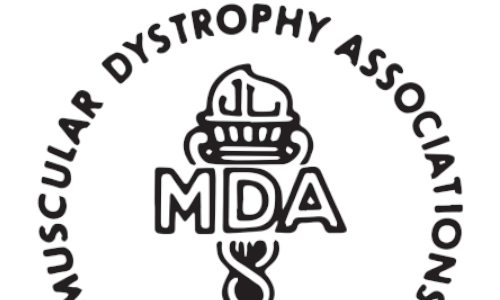
1950
The Muscular Dystrophy Association of America is Founded

On June 6, 1950, Paul Cohen, a prominent New York businessman and founder of the Technical Tape Corporation, took a monumental step in addressing a personal cause close to his heart. Living with facioscapulohumeral muscular dystrophy (FSHD), Cohen understood firsthand the challenges of navigating life with a progressive neuromuscular disease. Recognizing the urgent need for action, he invited a group of like-minded individuals to meet in his Rye, NY, office. Each attendee shared a personal connection to muscular dystrophy, whether through their own diagnosis, a loved one, or a desire to help those affected by these debilitating diseases.
The group’s discussion centered on the dire need to raise funds to advance research and seek meaningful treatments and potential cures for muscular dystrophies. At the time, very few resources were allocated to studying these rare and poorly understood conditions, and the medical community had limited avenues to pursue answers. Motivated by this shared urgency, the group decided to formalize their efforts, creating what would soon become the Muscular Dystrophy Association of America (MDAA). This pivotal meeting laid the groundwork for an organization that would go on to revolutionize the landscape of neuromuscular disease research, care, and advocacy.
Just two months later, the fledgling organization made its first significant impact, awarding a research grant to Dr. Ade Milhorat at New York Hospital Cornell Medical Center. Dr. Milhorat was one of the few physicians in the world conducting dedicated research on muscular dystrophies, but his work was at risk of being discontinued due to a lack of funding. MDA’s timely support not only enabled Dr. Milhorat to continue his groundbreaking research but also underscored the organization’s commitment to ensuring progress in an area of medicine that had been neglected. Without this intervention, his research—and its potential to pave the way for future advancements—might have been lost.
What began as a small, passionate group united by a shared purpose in Paul Cohen’s office has since grown into a global force, continuing to drive innovation and transform lives for individuals and families impacted by neuromuscular diseases.
Learn more at MDA75.org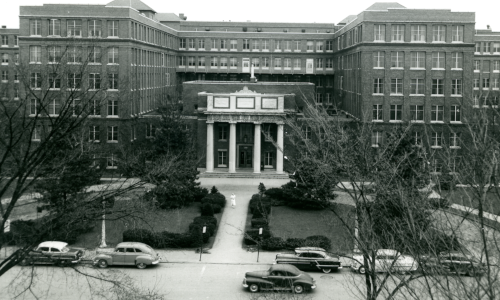
1953
The First MDA Care Centers Are Established

In 1953, the Muscular Dystrophy Association (MDA) established its first specialized clinics—now known as MDA Care Centers—at New York University (NYU) Langone Health and the University of Rochester Medical Center. These early centers represented a groundbreaking step in addressing the unmet needs of children and adults living with neuromuscular disease, providing a foundation for the specialized care and research integration that defines the MDA Care Center Network today.
At the time, neuromuscular diseases were poorly understood, and there were few resources or dedicated care options for patients. These initial clinics focused on offering specialized expertise for diagnosis and management, creating a much-needed link between patients and healthcare providers with knowledge of these rare conditions.
Over time, the MDA Care Center Network has evolved into a comprehensive system of care that bridges clinical practice and research. Today, it is comprised of 150 centers nationwide, including 45 MDA/ALS Care Centers, where expert clinicians provide access to the latest treatments, research opportunities, and support resources. This network remains a critical resource for advancing clinical standards and furthering collaboration among researchers, scientists, and clinicians.
The development of the MDA Care Center Network highlights MDA’s long-standing commitment to improving care and supporting progress in neuromuscular medicine. What began as a response to a pressing need has grown into a platform that empowers clinicians and scientists to expand the frontiers of care and innovation, ensuring that patients and families receive the support they need.
Find an MDA Care Center Near You
1955
MDA Launches Inaugural MDA Summer Camp

In 1955, the Muscular Dystrophy Association (MDA) launched its inaugural Summer Camp in Sussex, New Jersey, welcoming 16 children living with neuromuscular disease. This pioneering initiative provided a unique environment where campers could experience independence, build friendships, and enjoy recreational activities tailored to their abilities.
The success of this initial camp underscored the importance of accessible recreational opportunities for children with neuromuscular conditions. Over the years, MDA Summer Camps have expanded significantly, becoming a cherished annual tradition across multiple sites nationwide. These camps offer thousands of children the chance to explore their potential, make lifelong connections, and enjoy a fully accessible camp experience.
Each camp session is designed to accommodate the unique needs of its participants, ensuring that all activities—from swimming and horseback riding to arts and crafts—are accessible and inclusive. The camps are staffed by dedicated volunteers and healthcare professionals who provide personalized care and support, allowing campers to engage fully in the experience.
For many children, MDA Summer Camp is more than just a week of fun; it's an opportunity to develop greater self-esteem and confidence and spend time with peers who understand what it’s like to live with a neuromuscular disease. Parents also benefit from the respite these camps provide, knowing their children are in a safe and supportive environment.
The enduring success of MDA Summer Camps reflects MDA’s commitment to enhancing the quality of life for children with neuromuscular diseases. By continually adapting and expanding these programs, MDA ensures that each new generation of campers can enjoy the freedom, joy, and camaraderie that have defined the camp experience since its inception.
Volunteer at an MDA Summer Camp
1971
The Jerry Lewis MDA Labor Day Telethon Telecast Across The Country

The story of the Jerry Lewis MDA Telethon begins with the early involvement of comedy duo Dean Martin and Jerry Lewis. In January 1952, Martin and Lewis expanded MDA’s reach with an appeal during their nationally broadcast radio program, amplifying an initial televised fundraising effort. Later that year, they were named MDA National Co-Chairmen, cementing their roles as champions for the organization’s mission.
Fast forward to 1966, when Jerry Lewis hosted the first Labor Day Telethon on New York's WNEW-TV (now WNYW-TV). The 21½-hour broadcast, filled with live entertainment and emotional stories from MDA families, was an instant success, raising $1,002,114 in pledges. Its overwhelming impact led MDA to make the Labor Day Telethon an annual tradition, with the event becoming a signature moment in American fundraising history.
The Telethon’s national expansion began in 1971 with the creation of the “Love Network.” Under the guidance of broadcasting innovators Sylvester “Pat” Weaver, former President of NBC and creator of the “Today” and “Tonight” shows, and Robert M. Bennett, President of Metromedia Broadcasting, the Love Network brought together stations across the country. This collaboration allowed MDA to reach millions of households, transforming the Telethon into a nationwide phenomenon.
For nearly five decades, the Jerry Lewis MDA Labor Day Telethon served as a powerful platform for raising awareness and funds to advance MDA’s mission. With its blend of star-studded performances, heartfelt testimonials, and Jerry Lewis’s impassioned appeals, the Telethon united Americans in support of families affected by neuromuscular diseases. The iconic tote boards tracking pledged donations symbolized the incredible generosity of viewers, culminating in hundreds of millions of dollars raised over the years.
Although the traditional telethon concluded its remarkable run in 2014, its legacy endures as a testament to the power of storytelling, community, and dedication. The funds raised over its nearly 50-year history not only propelled cutting-edge research but also laid the foundation for MDA’s lasting impact in care, advocacy, and community programs.
Make a Difference for People Living with Neuromuscular Disease
Get Involved
1983
The Orphan Drug Act (ODA) Of 1983 Enacted

The Orphan Drug Act (ODA) of 1983 was a landmark piece of legislation enacted to address a critical gap in the pharmaceutical industry: the lack of research and development into treatments for rare diseases. These conditions, often referred to as “orphan diseases,” affect small patient populations, making them financially unviable for traditional drug development pipelines. The ODA was designed to change this by providing targeted incentives to encourage pharmaceutical companies and researchers to invest in therapies for these underserved communities.
MDA played an important role in the passage of the Orphan Drug Act, using our platform to raise awareness of the challenges faced by people living with rare neuromuscular diseases and mobilizing the community to advocate for change. By highlighting the urgent need for therapies for conditions with small patient populations, MDA helped to build public and legislative support for this legislation.
Key provisions of the Orphan Drug Act included tax credits for the costs of clinical trials, seven years of market exclusivity for approved orphan drugs, and access to federal grants to support early-stage research. The Act also established the Office of Orphan Products Development (OOPD) within the U.S. Food and Drug Administration (FDA) to oversee and advance efforts under the program. These incentives created a framework that significantly reduced the financial and regulatory barriers associated with developing treatments for rare diseases.
The impact of the Orphan Drug Act has been profound. In the decade prior to its passage, only 10 treatments for rare diseases were approved in the United States. In the years following the ODA’s enactment, hundreds of orphan drugs have been developed, transforming the landscape of care for individuals with rare conditions. Many of these breakthroughs have provided hope to patients and families affected by neuromuscular diseases, which are included among the conditions classified as rare under the Act.
MDA’s advocacy and ongoing commitment to funding groundbreaking research have ensured that the Orphan Drug Act continues to benefit people living with neuromuscular diseases. By prioritizing the needs of small patient populations and aligning incentives with innovation, the Act catalyzed progress in areas where few options previously existed.
Become an MDA Advocate Today!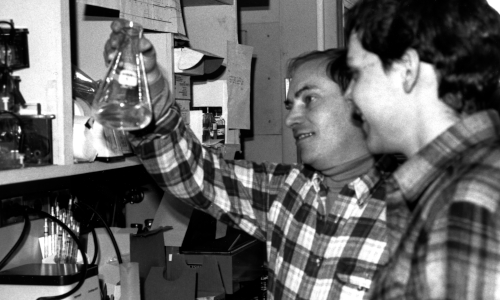
1986
MDA-Funded Discovery Of The DMD Gene Launches A New Era In Genetic Research And Therapies

In 1986, a groundbreaking discovery funded by the Muscular Dystrophy Association (MDA) ushered in a new era of genetic research and therapies. Dr. Lou Kunkel, an MDA-funded researcher, and his team identified the gene responsible for Duchenne muscular dystrophy (DMD) and Becker muscular dystrophy (BMD). This landmark discovery represented the first time a gene associated with a neuromuscular disease had been identified, setting the stage for targeted research and therapeutic innovation.
The identification of the DMD gene was a monumental achievement, as it revealed the genetic underpinnings of these progressive muscle-wasting conditions. Dr. Kunkel’s work also marked the beginning of the “gene discovery era,” transforming the scientific understanding of neuromuscular diseases and expanding the possibilities for precision medicine. This research illuminated how mutations in the dystrophin gene disrupt the production of a critical protein that maintains muscle integrity, providing a clear target for developing potential treatments.
MDA’s investment in genetic research played a pivotal role in facilitating this breakthrough. By supporting Dr. Kunkel and his team, MDA not only advanced understanding of Duchenne and Becker muscular dystrophy but also laid the groundwork for broader research into the genetic causes of neuromuscular diseases. The discovery catalyzed further investigations into the role of genes in disease progression, sparking a wave of innovation that continues to shape the field of neuromuscular medicine.
The implications of the DMD gene discovery have been profound. It paved the way for the development of genetic therapies, including exon-skipping drugs, gene-editing technologies like CRISPR, and advances in gene therapy approaches. These treatments, some of which are now available, have the potential to slow disease progression and improve quality of life for individuals with Duchenne and Becker muscular dystrophy.
Today, MDA continues to build on this legacy, funding research and fostering collaboration to translate genetic discoveries into real-world treatments. The identification of the DMD gene remains a watershed achievement, demonstrating the transformative impact of sustained research investment and scientific dedication on the neuromuscular community.
Learn More about MDA’s Unique Approach to Research
1990
Americans With Disabilities Act (ADA) Signed Into Law

On July 26, 1990, the Americans with Disabilities Act (ADA) was signed into law by President George H.W. Bush, marking a pivotal moment in the fight for civil rights and inclusion. This groundbreaking legislation was designed to eliminate physical, social, and systemic barriers faced by people with disabilities, ensuring equal access to employment, public services, transportation, and other aspects of daily life.
The ADA’s passage was the result of years of determined advocacy by disability rights activists, community organizations, and allies. Among those championing the cause, MDA played a critical role by highlighting the urgent need for policies that would remove obstacles to full participation in society for people with disabilities.
The ADA established a comprehensive framework for disability rights, requiring accommodations in workplaces, public spaces, and transportation systems to promote accessibility and inclusion. It also prohibited discrimination against individuals with disabilities in employment and mandated reasonable accommodations, enabling more people to contribute their skills and talents in the workforce.
For the neuromuscular community, the ADA was transformative. It provided legal protections that addressed challenges related to mobility, communication, and access to essential services. Wheelchair ramps, accessible public transportation, and adapted technologies that are now commonplace owe much of their prevalence to the standards set by the ADA.
The impact of the ADA continues to resonate today, shaping societal attitudes and promoting greater inclusivity. MDA actively advocates for policies that uphold the principles of the ADA, to ensure that the progress achieved through this historic legislation continues to evolve, creating a world where accessibility and opportunity are the norm, not the exception.

1999
MDA Funds First Clinical Trial For Gene Therapy For Any Type Of Muscular Dystrophy

In 1999, the Muscular Dystrophy Association (MDA) broke new ground in medical research by funding the first-ever clinical trial for gene therapy targeting any type of muscular dystrophy. This historic trial, led by renowned researcher Dr. Jerry Mendell, represented an early step in exploring the potential of gene therapy for neuromuscular diseases.
The trial focused on limb-girdle muscular dystrophy (LGMD) type 2, a progressive condition caused by genetic mutations that affect muscle strength and function. The study aimed to assess the feasibility of delivering a therapeutic gene to muscle cells as a potential approach for addressing the disease. While the trial was ultimately interrupted, it contributed valuable insights that helped shape the future of gene therapy for neuromuscular disorders.
MDA’s support for this pioneering research reflected its long-standing commitment to advancing treatments that extend beyond symptom management. By funding innovative projects like Dr. Mendell’s, MDA played a crucial role in expanding the understanding of gene-based therapies and accelerating their development for neuromuscular diseases.
Although this early trial did not reach completion, it helped pave the way for future research efforts. It inspired continued exploration into gene therapy approaches for a range of neuromuscular diseases, including spinal muscular atrophy (SMA) and additional forms of limb-girdle muscular dystrophy (LGMD). Over the following decades, gene therapy has evolved into a transformative area of medicine, leading to groundbreaking treatments that are now approved for clinical use and others currently in development.
Dr. Mendell’s work, supported by MDA, remains foundational to ongoing advancements in genetic therapies for neuromuscular diseases. The legacy of this trial continues to inspire researchers, clinicians, and the neuromuscular community, driving innovation and expanding possibilities for people living with muscular dystrophy and other neuromuscular conditions.
Learn more about the 300+ neuromuscular disorders at the center of MDA's mission.

2001
U.S. Congress Passes The MD-Care Act

In 2001, the passage of the Muscular Dystrophy Community Assistance, Research, and Education (MD CARE) Act marked a transformative moment in the fight against muscular dystrophy. Championed by the Muscular Dystrophy Association (MDA), its community of advocates, and key allies, this landmark legislation significantly expanded federal support for research, clinical care, and resources for individuals and families impacted by muscular dystrophy across the United States. The Act not only prioritized research but also strengthened the national infrastructure for care and patient support.
Central to the MD CARE Act was the establishment of Centers of Excellence for muscular dystrophy. These specialized hubs became focal points for advanced research, clinical care, and patient resources, adopting a multidisciplinary approach to addressing neuromuscular diseases. By bringing together leading researchers, clinicians, and healthcare providers, the Centers of Excellence facilitated collaboration and innovation, enabling significant progress in understanding and treating muscular dystrophy.
The Act also enhanced coordination among federal agencies, including the National Institutes of Health (NIH) and the Centers for Disease Control and Prevention (CDC), to streamline research funding and data collection efforts. These initiatives accelerated the development of new treatments and expanded resources to better support individuals and families affected by muscular dystrophy.
The impact of the MD CARE Act continues to be felt today. It has led to significant advances in research, including the development of new therapies and clinical trials, while improving access to specialized care through its emphasis on building a robust national infrastructure. For the neuromuscular community, the Act represents a pivotal achievement that has transformed the landscape of muscular dystrophy care and research.
MDA remains deeply involved in advocating for the ongoing reauthorization and funding of the MD CARE Act to ensure its legacy endures. This commitment reflects MDA’s dedication to advancing care, accelerating research, and improving outcomes for individuals living with neuromuscular diseases.
Learn More About MDA’s Legislative Priorities
2003
The Centers Of Excellence Program In Muscular Dystrophy Research Is Established By NIH

In 2003, the National Institutes of Health (NIH) established the Centers of Excellence program in muscular dystrophy research to advance understanding and treatment of these complex conditions. These specialized hubs were designed to encourage collaboration among researchers, clinicians, and healthcare providers, focusing on translating basic research into clinical applications, enhancing diagnostics, and developing new therapies. The program also emphasizes the importance of cross-institutional partnerships to accelerate progress and ensure that scientific discoveries lead to real-world improvements in care.
MDA’s advocacy and research investments have been instrumental in shaping the landscape that made the Centers of Excellence possible. By funding foundational research and mobilizing community support for initiatives like the MD CARE Act, MDA has helped create an environment where collaboration and innovation thrive.
This initiative was later named the Paul D. Wellstone Muscular Dystrophy Cooperative Research Centers in honor of the late Senator Paul D. Wellstone, a champion for the neuromuscular community and a driving force behind the MD CARE Act. The Wellstone Centers embody the core principles of the Centers of Excellence model by prioritizing innovation, collaboration, and a patient-focused approach to research.
Through these Centers, the neuromuscular community has seen significant advancements in understanding the genetic and molecular basis of muscular dystrophies, as well as the development of promising new therapeutic approaches. By integrating research and clinical expertise, the Centers of Excellence program strengthens the infrastructure needed to support meaningful progress in muscular dystrophy research and care.

2006
MDA Funds The First-Ever Gene Therapy Trial For Duchenne Muscular Dystrophy

In 2006, the Muscular Dystrophy Association (MDA) funded the first-ever gene therapy trial for Duchenne muscular dystrophy (DMD), marking a transformative moment in the pursuit of neuromuscular disease treatments. This pioneering trial represented a bold step toward addressing the root causes of DMD, a severe and progressive genetic condition caused by mutations in the dystrophin gene. By supporting this groundbreaking effort, MDA helped lay the foundation for the future of gene therapy in the neuromuscular field.
The trial, led by Dr. Jerry Mendell, focused on the potential of gene-based approaches to restore dystrophin production in affected muscle cells. It demonstrated the feasibility of using gene therapy to target the underlying genetic defect, paving the way for subsequent advancements in genetic medicine. This breakthrough not only opened the door to innovative therapies for Duchenne but also inspired new research directions for a range of neuromuscular diseases, including Becker muscular dystrophy and limb-girdle muscular dystrophy.
MDA’s investment in this trial reflected its mission to accelerate research that could lead to transformative treatments for individuals and families living with neuromuscular diseases. By funding bold, forward-looking initiatives, MDA has consistently driven progress in the field, fostering collaboration among researchers, clinicians, and biotech companies to turn scientific discoveries into real-world solutions.
The success of the 2006 trial set a new course for treatment possibilities, highlighting the promise of gene therapy as a tool to combat genetic neuromuscular conditions. Today, gene-based treatments, including exon-skipping drugs and advances in gene-editing technologies, owe much of their development to the groundwork laid by early trials like this one. MDA continues to champion research into gene therapy and other innovative approaches, ensuring that the momentum built by this milestone continues to benefit the neuromuscular community for generations to come.
Explore MDA grant funding opportunities for cutting-edge neuromuscular research.
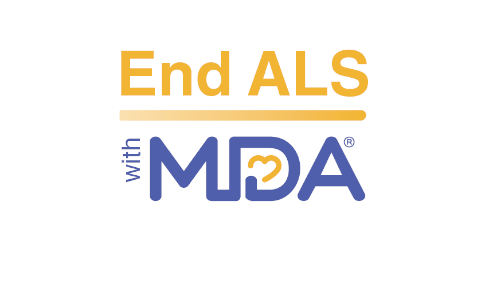
2011
Identification Of C9ORF Mutations In ALS

In 2011, the discovery of the C9ORF72 gene mutation marked a significant breakthrough in understanding amyotrophic lateral sclerosis (ALS) and frontotemporal dementia (FTD). This mutation, now recognized as the most common genetic cause of both conditions, provided critical insight into the underlying mechanisms driving these progressive neurodegenerative diseases. The identification of C9ORF72 represented a pivotal moment in ALS and FTD research, opening the door to more targeted approaches for diagnosis, treatment, and potential therapies.
MDA played a vital role in supporting the research environment that led to this discovery, reflecting our commitment to advancing knowledge about the genetic and molecular basis of neuromuscular diseases. By funding foundational studies and fostering collaboration within the research community, MDA helped set the stage for breakthroughs like the identification of C9ORF72, which has since revolutionized how scientists and clinicians approach ALS and related conditions.
The discovery of the C9ORF72 mutation has had far-reaching implications. It revealed a unique mechanism involving toxic RNA repeats, which disrupt cellular processes and contribute to disease progression. This finding not only enhanced understanding of ALS and FTD but also inspired new research into therapeutic strategies, including RNA-targeted treatments and gene-editing technologies. These efforts hold the promise of slowing disease progression or addressing the root cause of the condition.
For individuals and families affected by ALS and FTD, the recognition of C9ORF72 as a common genetic driver underscores the importance of genetic testing, early diagnosis, and personalized care strategies. MDA continues to champion research into the genetic and molecular pathways of ALS, ensuring that discoveries like C9ORF72 translate into tangible benefits for the neuromuscular community.
The identification of the C9ORF72 mutation exemplifies the power of scientific discovery to illuminate pathways to better treatments and hope for the future.
Learn how MDA advances discoveries like C9ORF72 through annual research grant funding.
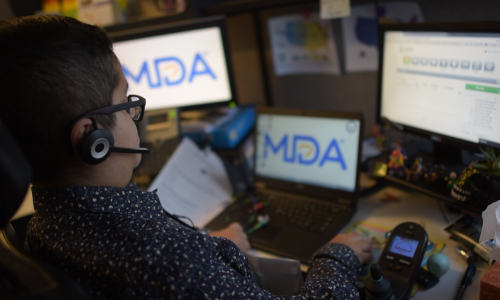
2015
MDA Establishes The MDA Resource Center To Provide Trusted Guidance And Support Nationwide

In 2015, the Muscular Dystrophy Association (MDA) launched the MDA Resource Center, establishing a national information hub dedicated to supporting individuals and families navigating life with neuromuscular diseases. Designed to address the unique needs and questions of the neuromuscular community, the Resource Center serves as a trusted source of information, guidance, and compassionate support, connecting people to practical solutions and empowering them to make informed decisions about care and resources.
The Resource Center embodies MDA’s commitment to enhancing the quality of life for people living with neuromuscular diseases. Through its dedicated staff, including trained specialists, and its wealth of curated resources, the MDA Resource Center provides personalized assistance on a wide range of topics. Whether helping families understand complex medical information, access community programs, or locate care through the MDA Care Center Network, the Resource Center ensures that no one feels alone in their journey.
This service reflects MDA’s mission to provide not only expert care and research but also meaningful support to individuals and families. By making reliable information readily available, the Resource Center helps people navigate challenges with confidence, offering tools to improve daily living, connect with others, and advocate for their needs.
Since its inception, the MDA Resource Center has become a vital lifeline for tens of thousands of families nationwide. As part of our broader mission, MDA remains dedicated to expanding access to resources, ensuring that individuals and families have the knowledge and support to meet each day with resilience and hope.

2016
FDA Approves Exondys 51 (Etepllirsen) For The Treatment Of DMD

In 2016, the U.S. Food and Drug Administration (FDA) approved Exondys 51 (eteplirsen), the first-ever therapy specifically targeting the underlying genetic cause of Duchenne muscular dystrophy (DMD). This landmark approval represented a pivotal moment in the fight against DMD, offering a new therapeutic option for individuals with certain mutations in the dystrophin gene and paving the way for further innovation in genetic medicine.
Exondys 51 uses an exon-skipping approach to address mutations in exon 51 of the dystrophin gene, enabling the production of a functional, albeit shortened, version of the dystrophin protein. For eligible patients, this therapy offers the potential to slow the progression of DMD, a condition characterized by severe and progressive muscle weakness. Its approval marked a significant step forward for the neuromuscular community, offering hope to families who had long awaited targeted treatments for this devastating condition.
The approval of Exondys 51 was made possible in part by years of foundational research supported by the Muscular Dystrophy Association (MDA). MDA played a critical role in funding early studies that advanced exon-skipping technology and advocating for policies that promote the development and approval of therapies for neuromuscular diseases. Through our collaboration with researchers, biotech companies, and regulatory agencies, MDA helped create an environment where transformative therapies like Exondys 51 could become a reality.
This milestone also underscored the importance of patient advocacy in shaping drug development and approval processes. The neuromuscular community, including families, researchers, and organizations like MDA, was instrumental in highlighting the urgent need for innovative treatments and ensuring that patient voices were heard throughout the regulatory process.
Exondys 51’s approval marked the beginning of a new era in DMD treatment and catalyzed further advancements in gene-based therapies. Today, the lessons learned from this breakthrough continue to inform the development of additional therapies for DMD and other neuromuscular diseases. MDA remains committed to funding research and advocating for innovative solutions, ensuring that people living with DMD and other neuromuscular conditions have access to life-changing treatments and care.
Learn about other potential treatments currently in the clinical trial phase.
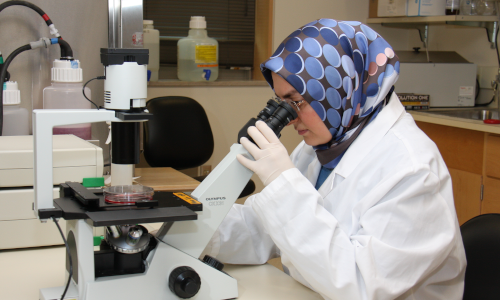
2016
FDA Approves Spinraza (Nusinersen) For The Treatment Of SMA

In 2016, the U.S. Food and Drug Administration (FDA) approved Spinraza (nusinersen), the first-ever treatment for spinal muscular atrophy (SMA). This groundbreaking therapy represented a life-changing advancement for individuals affected by SMA, a severe neuromuscular disease that is the leading genetic cause of death in infants and young children. Spinraza offered hope to families who had long awaited a therapy to address the underlying cause of this devastating condition.
Spinraza is an antisense oligonucleotide that targets the SMN2 gene to increase production of the survival motor neuron (SMN) protein, which is critical for muscle function and survival. By addressing the genetic defect that causes SMA, Spinraza not only improves motor function but also extends life expectancy for many individuals with SMA. Its approval signaled a transformative moment in the treatment landscape for neuromuscular diseases.
The Muscular Dystrophy Association (MDA) played a pivotal role in the journey to this milestone. Through decades of funding foundational SMA research, including studies on the SMN protein and the genetic underpinnings of SMA, MDA helped create the scientific foundation for Spinraza’s development. MDA also supported advocacy efforts to prioritize SMA research and ensure that therapies like Spinraza could reach patients as quickly as possible.
Spinraza’s approval also underscored the importance of community involvement in advancing treatments. Families and advocates within the SMA and neuromuscular communities, supported by organizations like MDA, worked tirelessly to highlight the need for innovative therapies and to provide critical input throughout the drug development and approval process.
Since its approval, Spinraza has transformed the standard of care for SMA, offering improved quality of life and new possibilities for individuals across all types and ages affected by the condition. This milestone has inspired ongoing research into gene-based and other therapies, with the potential to further improve outcomes for the SMA community.
The approval of Spinraza represents the culmination of years of collaborative effort and a testament to what is possible when science, advocacy, and community come together.
Discover MDA’s Clinician Industry Update Webinars for direct insights from industry experts.

2018
MDA Launches The MOVR Data Hub™

In 2018, the Muscular Dystrophy Association (MDA) launched the MOVR (NeuroMuscular ObserVational Research) Data Hub, a revolutionary neuromuscular disease data platform designed to centralize clinical information from MDA Care Centers across the country. As the first and only data hub of its kind for neuromuscular diseases, MOVR provides a unified, comprehensive resource that empowers researchers, clinicians, and healthcare providers with real-time insights to drive progress in understanding, treating, and managing these complex conditions.
MOVR collects and organizes data across multiple neuromuscular diseases, including Duchenne muscular dystrophy (DMD), Becker muscular dystrophy (BMD), limb-girdle muscular dystrophy (LGMD), spinal muscular atrophy (SMA), and amyotrophic lateral sclerosis (ALS). By integrating data from MDA’s extensive Care Center Network, MOVR offers an unparalleled view of disease patterns, treatment outcomes, and patient-reported needs. This centralized approach accelerates research, informs care practices, and supports the development of innovative therapies.
The creation of MOVR reflects MDA’s commitment to advancing the field of neuromuscular medicine. By leveraging data to identify trends and gaps in care, MOVR equips clinicians and researchers with the tools needed to optimize treatment approaches and improve quality of life for individuals living with neuromuscular diseases. Additionally, the platform supports patient registries and clinical trials, ensuring that emerging therapies are informed by robust, real-world evidence.
MOVR’s impact extends beyond research and care. By uniting data from diverse neuromuscular conditions into a single, accessible hub, the platform enhances collaboration among stakeholders, including researchers, pharmaceutical companies, and healthcare providers. This collaborative ecosystem not only enhances the efficiency of clinical research but also lays the groundwork for future therapeutic discoveries that have the potential to transform lives.
By harnessing the power of data, MOVR drives advancements that bring the promise of better care, innovative treatments, and a deeper understanding of neuromuscular diseases closer to reality.
Explore MDA’s MOVR Data Hub for real-time, centralized neuromuscular disease insights.

2019
FDA Approves Zolgensma (onasemnogene abeparvovec-xioi) For The Treatment Of SMA

In 2019, the U.S. Food and Drug Administration (FDA) approved Zolgensma (onasemnogene abeparvovec-xioi), the first gene therapy for spinal muscular atrophy (SMA), offering a transformative treatment option for this neuromuscular disease. Zolgensma, designed to address the genetic root cause of SMA, is a one-time therapy that delivers a functioning copy of the SMN1 gene, enabling the production of the survival motor neuron (SMN) protein critical for muscle function and survival.
The development of Zolgensma was a milestone in genetic medicine and the result of decades of groundbreaking research by numerous scientists. Among the key contributors were Dr. James Wilson, whose pioneering work at the University of Pennsylvania led to the discovery of adeno-associated viruses (AAVs) as vectors to deliver healthy DNA into cells, and Dr. Brian Kaspar, who, while at Nationwide Children’s Hospital, demonstrated that AAV9 vectors could cross the blood-brain barrier to deliver genes to motor neurons. Their discoveries laid the scientific foundation for the development of Zolgensma and its use as a gene therapy for SMA.
The Muscular Dystrophy Association (MDA) played a crucial role in advancing the science that made Zolgensma possible. Through decades of funding basic and translational research, including studies on the SMN1 gene and gene delivery mechanisms, MDA supported the work of scientists whose discoveries informed the development of this life-changing therapy. Additionally, MDA’s advocacy efforts helped create an environment where innovative treatments for rare diseases like SMA could receive the attention and resources they needed.
The approval of Zolgensma marked a turning point for the SMA community. By addressing the underlying genetic defect with a one-time treatment, Zolgensma offers hope for improved outcomes, especially when administered early in the course of the disease. It represents a critical step toward changing the trajectory of SMA, providing new possibilities for individuals and families affected by this condition.
The success of Zolgensma underscores the importance of collaboration between scientists, clinicians, and organizations like MDA in driving progress toward better treatments and brighter futures for people living with neuromuscular disease.
Read more about the revolutionary decade for spinal muscular atrophy therapies.

2019
MDA Hosts First Combined Clinical And Scientific Conference

In 2019, the Muscular Dystrophy Association (MDA) hosted our inaugural combined Scientific and Clinical Conference, marking a significant step forward in advancing the field of neuromuscular disease research and care. The conference brought together leading researchers, clinicians, and healthcare professionals from across the globe in a single event to foster collaboration, share knowledge, and discuss the latest breakthroughs in the fight against neuromuscular diseases.
This landmark conference created a unique platform for experts to connect across disciplines, bridging the gap between scientific discovery and clinical application. By uniting stakeholders from diverse areas of expertise, the event encouraged the integration of cutting-edge research into patient care, helping to translate laboratory findings into real-world therapies and improved care practices. Topics ranged from gene therapy and molecular pathways to innovative care strategies and patient-centered approaches, ensuring a comprehensive exploration of the challenges and opportunities in neuromuscular disease treatment.
MDA’s leadership in hosting this conference underscored our commitment to accelerating progress in neuromuscular disease. By providing a space for the exchange of ideas and the formation of collaborative networks, MDA played a critical role in driving innovation and aligning the efforts of the medical and scientific communities. The event highlighted the importance of cross-disciplinary partnerships in addressing the complexities of neuromuscular diseases and ensuring that the latest advancements benefit individuals and families as quickly as possible.
MDA’s combined Scientific and Clinical Conference has since become a cornerstone event, reflecting our dedication to uniting the global neuromuscular community in pursuit of better treatments, innovative solutions, and improved care.
MDA Conference
2023
MDA Introduces The Gene Therapy Support Network

In 2023, the Muscular Dystrophy Association (MDA) introduced the Gene Therapy Support Network to meet the evolving needs of individuals and families exploring gene therapy as a treatment option for neuromuscular diseases. This initiative offers practical, accessible resources designed to demystify the complexities of gene therapy, providing the tools families need to make informed decisions during a time of significant medical innovation.
As gene therapies become available for conditions like spinal muscular atrophy (SMA) and Duchenne muscular dystrophy (DMD), the Gene Therapy Support Network serves as a reliable source of information. Families can access educational materials tailored to their needs, consult with specialists familiar with gene therapy protocols, and receive guidance on treatment eligibility, logistics, and long-term care considerations. By addressing these critical aspects, the program ensures individuals can approach gene therapy with a clear understanding of its potential benefits and challenges.
The Gene Therapy Support Network represents a natural extension of MDA’s commitment to the neuromuscular community, consistent with our focus on providing resources that align with the latest advancements in care. This program also acknowledges the unique questions and uncertainties families face when considering therapies that represent a new frontier in treatment. With its focus on clarity, access, and personalized support, the Gene Therapy Support Network increases confidence and empowerment for people exploring these transformative options.
By uniting education, expert consultation, and compassionate assistance, this initiative supports families in navigating a complex and often unfamiliar aspect of modern medicine. It highlights the importance of ensuring that scientific advancements translate into accessible and meaningful benefits for people living with neuromuscular diseases.
Connect today with personalized support from the MDA Gene Therapy Support Network.

2024
All 50 States And DC Implement Newborn Screening For SMA

In 2024, newborn screening for spinal muscular atrophy (SMA) was implemented in all 50 states and Washington, DC, marking a significant milestone in the fight against this life-threatening neuromuscular disease. This achievement ensures that every newborn in the United States has access to early diagnosis and the opportunity for timely intervention during the most critical stages of development.
Newborn screening for SMA is a game-changer for families, as early detection allows for immediate access to care and treatments that can dramatically improve health outcomes. Identifying SMA at birth ensures that life-saving therapies, including gene therapies and other advanced treatments, can be administered before symptoms progress, offering children the best chance at a longer and healthier life.
This nationwide implementation was made possible through the combined efforts of many stakeholders, including patient advocates, researchers, clinicians, and public health officials. MDA has been an active voice in this effort, working alongside partners to advocate for the inclusion of SMA in state newborn screening panels, raise awareness of its importance, and support families navigating the screening process.
The implementation of universal newborn screening for SMA not only reflects advances in medical science but also highlights the power of collaboration in improving access to care for rare diseases. With early detection now available to every family in the United States, the neuromuscular community has taken a significant step forward in ensuring that no child with SMA is left undiagnosed or untreated. This milestone underscores the importance of early intervention in transforming outcomes for children and families affected by neuromuscular diseases.
Learn more about the importance of newborn screening for neuromuscular diseases.